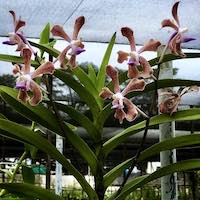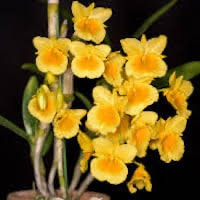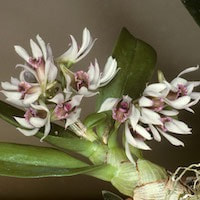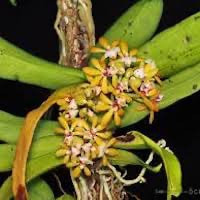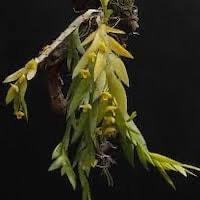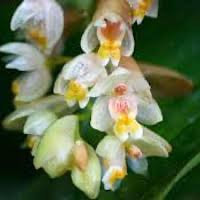Experience the Tranquil Woody Essence of Women Fragrance Oil Woody 7
The fragrance composition of the following orchids and their herbal usage is as follows:
Aranda Peng Lee Yeoh: This hybrid orchid, registered by Yeoh Bok Choon in 1966, is native to Singapore and has a distinct vanilla fragrance that children often mistake for a "chocolate orchid." In the Woody 7 (Women) Team Building Perfume Workshop, its woody mix is incorporated, making it a valuable addition to the collection.
Dendrobium capillipes Rchb. f.: Distributed across Nepal, Northeast India, Yunnan, Myanmar, Thailand, Laos, and Cambodia, this orchid contains Scoparone, which has vasodilatory effects on the rat aorta. It also shows potential for stimulating dopamine biosynthesis, making it relevant for potential use in treating Parkinson's disease.
Dendrobium monticola P.F. Hunt & Summerh.: Found in the eastern Himalayas to Laos and Vietnam, this tiny Dendrobium has stumpy, clustered pseudobulbs. In India and Nepal, it is used as an emollient or in poultices to treat skin lesions and rheumatism, and it is sold in the drug markets of Kanpur as a nerve tonic.
Gastrochilus obliquus (Lindl.) Kuntze: Distributed from Nepal, Bhutan, Sikkim, southwest Sichuan, southern Yunnan to Myanmar, Thailand, Laos, and Vietnam, this orchid is used by village folk in Thailand to treat body aches.
Oberonia longibracteata Lindl.: Found in Sri Lanka, the Indian Peninsula, Myanmar, Indochina, and Hainan Island, it is used in Kampuchea to treat scorpion bites.
Pholidota articulata Lindl.: This orchid grows on trees or shaded rocks at various altitudes across India, Nepal, Bhutan, Tibet, China, Myanmar, Thailand, Cambodia, Vietnam, Malaysia, and Indonesia. Its phytochemistry includes isoflavidinin, iso-oxoflavidinin A, and a novel 9,10-dihydrophenanthrene derivative named flavidin. It is used for various medicinal purposes, including treating coughs, headaches, and injuries, as well as being used as a stimulant, tonic, and to treat fractures in certain regions.
The overall fragrance of these orchids is enhanced by additional scent notes such as Oakmoss, Vetiver, Cedar, Tobacco, Spruce, and Thuja, creating unique and captivating aromas.
Aranda Peng Lee Yeoh: This hybrid orchid, registered by Yeoh Bok Choon in 1966, is native to Singapore and has a distinct vanilla fragrance that children often mistake for a "chocolate orchid." In the Woody 7 (Women) Team Building Perfume Workshop, its woody mix is incorporated, making it a valuable addition to the collection.
Dendrobium capillipes Rchb. f.: Distributed across Nepal, Northeast India, Yunnan, Myanmar, Thailand, Laos, and Cambodia, this orchid contains Scoparone, which has vasodilatory effects on the rat aorta. It also shows potential for stimulating dopamine biosynthesis, making it relevant for potential use in treating Parkinson's disease.
Dendrobium monticola P.F. Hunt & Summerh.: Found in the eastern Himalayas to Laos and Vietnam, this tiny Dendrobium has stumpy, clustered pseudobulbs. In India and Nepal, it is used as an emollient or in poultices to treat skin lesions and rheumatism, and it is sold in the drug markets of Kanpur as a nerve tonic.
Gastrochilus obliquus (Lindl.) Kuntze: Distributed from Nepal, Bhutan, Sikkim, southwest Sichuan, southern Yunnan to Myanmar, Thailand, Laos, and Vietnam, this orchid is used by village folk in Thailand to treat body aches.
Oberonia longibracteata Lindl.: Found in Sri Lanka, the Indian Peninsula, Myanmar, Indochina, and Hainan Island, it is used in Kampuchea to treat scorpion bites.
Pholidota articulata Lindl.: This orchid grows on trees or shaded rocks at various altitudes across India, Nepal, Bhutan, Tibet, China, Myanmar, Thailand, Cambodia, Vietnam, Malaysia, and Indonesia. Its phytochemistry includes isoflavidinin, iso-oxoflavidinin A, and a novel 9,10-dihydrophenanthrene derivative named flavidin. It is used for various medicinal purposes, including treating coughs, headaches, and injuries, as well as being used as a stimulant, tonic, and to treat fractures in certain regions.
The overall fragrance of these orchids is enhanced by additional scent notes such as Oakmoss, Vetiver, Cedar, Tobacco, Spruce, and Thuja, creating unique and captivating aromas.
Download the guided mediation that works best with this Orchid fragrance oil
| women_woody_essential_oil_orchi_00007.mp3 | |
| File Size: | 179206 kb |
| File Type: | mp3 |
Discover the Orchid's Healing Touch: A Fragrance for Women
Contains Scented Notes of following in various proportions:
Native Singaporean Orchid notes: Aranda Peng Lee Yeoh
|
Aranda Peng Lee Yeoh - Used in Woody 7 (Women) for Team building Perfume workshop
Aranda Peng Lee Yeoh is a hybrid orchid that holds a special place in the fragrance world. Although it is non-native, its unique scent and characteristics made it a great discovery for perfume enthusiasts. The hybrid was officially registered by Yeoh Bok Choon on the 1st of January, 1966. Since then, it has captivated many with its alluring aroma and stunning appearance. This remarkable orchid is native to Singapore and possesses a distinct fragrance that often surprises and delights children. Interestingly, young ones frequently mistake the scent for that of a "chocolate orchid." The sweet and inviting aroma that emanates from the flower resembles the delightful essence of vanilla, creating a fascinating olfactory experience. For those involved in the Woody 7 (Women) Team Building Perfume Workshop, Aranda Peng Lee Yeoh serves as an invaluable addition to their collection. It brings a unique and complex woody mix that is both captivating and sophisticated. While children may associate the fragrance with chocolate, perfume enthusiasts recognize the intricacies and depth of this exceptional orchid's scent. In the world of perfumery, finding an orchid with such a distinctive aroma is a treasure. The allure of Aranda Peng Lee Yeoh lies not only in its fragrance but also in its history and beauty. This remarkable hybrid has become a cherished gem among perfumers and has contributed to the creation of mesmerizing scents, making it a perfect choice for the Woody 7 (Women) Team Building Perfume Workshop. Its alluring aroma and complex woody notes make it a prized addition to any perfume collection, offering a one-of-a-kind olfactory experience. |
Therapeutic Orchid notes:
|
Dendrobium capillipes Rchb. f.
Chinese name: Duanbang Shihu It is distributed from Nepal and Northeast India to Yunnan, Myanmar, Thailand, Laos and Cambodia Phytochemistry: Scoparone (6,7-dimetho xycoumarine) which is present in D. capillipes has vasodilatory effects on the rat aorta. Dendrobium capillipes Rchb. f., commonly known as "Duanbang Shihu" in Chinese, is a captivating orchid species known for its unique scent and diverse herbal properties. This orchid is distributed across various regions, ranging from Nepal and Northeast India to Yunnan, Myanmar, Thailand, Laos, and Cambodia. The fragrance of Dendrobium capillipes is influenced by its phytochemistry, particularly the presence of Scoparone, a compound known for its distinct aroma. Scoparone is a 6,7-dimethoxycoumarine compound that contributes to the orchid's alluring scent. This aromatic compound has been found to have vasodilatory effects on the rat aorta, which means it can help relax and widen blood vessels, potentially offering therapeutic benefits related to cardiovascular health. Beyond its olfactory appeal, Dendrobium capillipes has also been the subject of scientific interest due to its medicinal properties. Phytohaemagglutinin, found in this orchid, stimulates white blood cells to rapidly replicate. This property is often utilized in laboratory settings for chromosomal analysis and immune system research. Moreover, Scoparone exhibits the ability to suppress the response of human mononuclear cells, providing potential applications in immune-modulatory therapies. Additionally, studies have shown that Scoparone stimulates dopamine biosynthesis by PC12 cells, which are nerve cells derived from a pheochromocytoma tumor in the rat adrenal medulla. This stimulation of dopamine production is particularly relevant as dopamine is a crucial chemical messenger in the brain. The loss of dopamine-secreting cells in the brain has been linked to the development of Parkinson's disease, making Scoparone's neuroprotective potential an intriguing avenue for further research and potential therapeutic use. In traditional herbal usage, Dendrobium capillipes is utilized as "shihu." Its herbal applications may include various medicinal purposes, such as promoting general well-being, supporting immune function, and potentially aiding in neurological health due to its influence on dopamine biosynthesis. The aromatic allure and pharmacological properties of Dendrobium capillipes make it a remarkable orchid species with both scientific and traditional significance. Its unique scent, coupled with its potential therapeutic benefits, adds to its appeal and highlights its importance as a valuable and multifaceted botanical resource. Further research into its phytochemistry and potential medicinal applications could lead to valuable insights and the development of new therapies in the field of medicine and perfumery. |
|
Dendrobium monticola P.F. Hunt & Summerh.
Indian names: Jiwanti, Bhotia, Lahsan Dendrobium monticola P.F. Hunt & Summerh. is an intriguing orchid species known for its delicate fragrance and diverse herbal applications. Referred to by various Indian names such as Jiwanti, Bhotia, and Lahsan, this tiny Dendrobium exhibits stumpy, clustered pseudobulbs and is found distributed across the eastern Himalayas to Laos and Vietnam. The captivating scent of Dendrobium monticola adds to its allure, making it a valuable botanical resource. In traditional herbal usage, this orchid plays a significant role in various medicinal practices. It is commonly employed as an emollient or in the form of a poultice to address skin-related issues such as pimples, boils, and other skin lesions. The application of this orchid in poultice form is believed to soothe and alleviate skin conditions, offering potential benefits for dermatological health. In India and Nepal, Dendrobium monticola is a notable component in traditional medicine, particularly in the region of Kanpur in the Indian northeastern state of Uttar Pradesh. It is sold in the local drug markets as a nerve tonic and antiphlogistic, indicating its potential use in promoting nervous system health and reducing inflammation. Furthermore, this orchid is applied externally to address rheumatism, showcasing its versatility as a botanical remedy for various bodily discomforts. The herbal usage of Dendrobium monticola highlights the importance of this orchid in indigenous healing practices, where its unique properties are harnessed to address specific health concerns. The rich cultural and traditional significance of this orchid further underscores its importance as a natural remedy in the regions where it is utilized. As scientific interest in medicinal plants continues to grow, further research into Dendrobium monticola's phytochemical composition and potential therapeutic benefits may unveil new possibilities in the fields of traditional medicine, herbal remedies, and dermatological care. The study of its fragrance compounds and potential physiological effects could lead to valuable insights into the development of new skincare products and perfumery applications. Overall, Dendrobium monticola stands as a fascinating orchid species that bridges the realms of natural fragrance and traditional medicine. Its unique scent, combined with its rich herbal properties, renders it a remarkable botanical treasure with the potential to provide holistic health benefits and aromatic delights to those who cherish and study its wondrous attributes. |
|
Gastrochilus obliquus (Lindl.) Kuntze
Chinese name: Wujingpenju Lan Thai names: Lin krabue noi; Sua luang; Chang rop kho Gastrochilus obliquus (Lindl.) Kuntze is a captivating orchid species renowned for its aromatic properties and traditional herbal usage in various regions of Asia. Referred to as Wujingpenju Lan in Chinese, and known by different Thai names such as Lin krabue noi, Sua luang, and Chang rop kho, this orchid species boasts a unique and alluring fragrance. The distribution of Gastrochilus obliquus spans across several countries, making it a geographically diverse species. Its natural habitat extends from Nepal, Bhutan, Sikkim, southwest Sichuan, and southern Yunnan to Myanmar, Thailand, Laos, and Vietnam. The orchid's presence in these regions has granted it cultural significance, becoming an integral part of local traditions and practices. In addition to its fragrance, Gastrochilus obliquus holds medicinal value in traditional herbal usage, particularly in Thailand. Among village communities in Thailand, the whole plant is utilized as a natural remedy to treat body aches. This underscores the plant's significance in local folk medicine, where its therapeutic properties are harnessed to alleviate discomfort and provide relief from various bodily pains. The traditional application of Gastrochilus obliquus for body aches reflects the rich botanical knowledge and healing practices passed down through generations. The recognition of its beneficial effects by local communities highlights the deep connection between people and nature, where indigenous plants like this orchid serve as valuable resources for holistic well-being. As the interest in natural remedies and traditional medicine continues to grow, there is potential for further research into the phytochemical composition of Gastrochilus obliquus. Exploring its fragrance compounds may offer insights into the creation of aromatic products and perfumery applications. Simultaneously, a deeper understanding of its medicinal properties could lead to the development of modern treatments for various ailments, enhancing the potential therapeutic benefits of this orchid. The fragrance and herbal usage of Gastrochilus obliquus intertwine, making it a significant cultural and botanical treasure in the regions where it is cherished. As we delve deeper into the wonders of the natural world and its various plant species, the allure of this orchid and its potential contributions to human well-being continue to captivate the realms of perfumery, traditional medicine, and ecological studies alike. |
|
Oberonia longibracteata Lindl.
Chinese name: Changbaoyuanwei Lan Oberonia longibracteata Lindl., known as Changbaoyuanwei Lan in Chinese, is an enigmatic orchid species with a remarkable distribution across diverse regions of Asia, including Sri Lanka, the Indian Peninsula, Myanmar, Indochina, and Hainan Island. This widespread occurrence showcases its adaptability and resilience in varying environmental conditions. One of the most intriguing aspects of Oberonia longibracteata is its aromatic profile and fragrance. However, comprehensive research on its scent compounds is yet to be fully explored. Understanding the chemical constituents responsible for its captivating aroma could shed light on its potential applications in the perfume industry and aromatherapy. The orchid's distribution in Vietnam includes habitats in dry lowland Dipterocarp forests and the central Annamese floristic province, where the prevailing high precipitation contributes to the unique ecological niches it occupies. This geographical diversity further accentuates the need to investigate the potential variations in its fragrance profile across different habitats. Apart from its aromatic allure, Oberonia longibracteata holds cultural significance in traditional medicine practices. In Kampuchea, it has been utilized for its purported medicinal properties in treating scorpion bites. The indigenous knowledge of local communities in Kampuchea and other regions highlights the historical connection between humans and the natural world, where plants have been revered for their healing potential and therapeutic benefits. While its herbal usage for scorpion bites is noteworthy, further research is required to explore the full range of its medicinal properties and potential active compounds. This could unlock new possibilities in modern herbal medicine and contribute to the ongoing quest for nature-inspired remedies. As we delve into the realm of botanical research, Oberonia longibracteata remains a captivating subject of study. Its intriguing fragrance, coupled with its traditional medicinal applications, adds to its allure and continues to inspire researchers to delve deeper into its mysteries. By uncovering the secrets of this orchid's scent and medicinal properties, we can gain a deeper understanding of its ecological importance and potential contributions to various industries, fostering a greater appreciation for the rich biodiversity of our natural world. |
|
Pholidota articulata Lindl.
Chinese name: Jiejinshixiantao (node stem, rock-living Immortal peach) Chinese medicinal name: Shilian (stone lotus), Shibangtui Indian name: Harjojan; Jivanti Myanmar name: Kwyet mee pan myo kywe Nepalese name: Thurjo, Pathakera Pholidota articulata Lindl., also known by various regional names such as Jiejinshixiantao in Chinese, Shilian or Shibangtui in Chinese medicine, Harjojan and Jivanti in India, Kwyet mee pan myo kywe in Myanmar, and Thurjo or Pathakera in Nepal, is a fascinating orchid species renowned for its aromatic allure and versatile medicinal properties. This exquisite orchid is naturally found growing on trees or shaded rocks at elevations ranging from 800 to 2500 meters. Its distribution spans across the regions of India, Nepal, and Bhutan, and extends further to encompass the provinces of southeast Tibet, southwest Sichuan, and Yunnan in China, as well as Myanmar (Kachin, Kayin, and Mon states), Thailand, Cambodia, Vietnam, Malaysia, and Indonesia. Such wide-ranging habitats have likely contributed to the development of unique scent variations and medicinal characteristics within this orchid species. Regarding its phytochemistry, researchers have isolated intriguing compounds from Pholidota articulata, including two 9,10-dihydrophenanthrenes, namely isoflavidinin and iso-oxoflavidinin A, along with a novel 9,10-dihydrophenanthrene derivative named flavidin. These compounds may be responsible for the captivating fragrance emitted by this orchid species, although further investigations are required to fully understand its complex aromatic profile. Moreover, the roots of Pholidota articulata have been found to host a diverse array of bacteria, including Pseudomonas, Flavobacterium, Stenotrophomonas, Pantoea, Chryseobacterium, Bacillus, Agrobacterium, Erwinia, Burkholderia, and Paracoccus strains. These bacteria produce indole-3-acetic acid (IAA), which plays a vital role in root formation and growth stimulation. Additionally, the orchid exhibits antibacterial activity against Staphylococcus and Bacillus subtilis, potentially offering valuable therapeutic benefits. Herbal usage of Pholidota articulata has a long history across various cultures. In traditional medicine practices, the whole plant, typically 30–50 g, is used to prepare decoctions, which are administered to treat various health conditions. It is believed to enrich yin, dispel gas, and reduce swelling. This orchid has been used to address respiratory issues, such as coughs due to body heat, as well as to alleviate headaches, dizziness, traumatic injuries, sores, ulcers, irregular menses, and uterine prolapse. In specific regions, such as Uttarakhand in the western Himalayas, Pholidota articulata is utilized for its unique ability to aid in the treatment of fractures. Its stimulant, demulcent, and tonic properties have been harnessed for various health purposes. In Nepal, the orchid holds a reputation as a tonic plant, with paste made from its pseudobulbs, especially the variety griffithii, being applied to dislocated bones. Furthermore, powdered roots are used to address cancer, while the juice extracted from the capsule is applied to treat skin eruptions and ulcers. Pholidota articulata, with its alluring fragrance and diverse medicinal applications, represents a rich cultural and scientific heritage. Its use in various traditional healing practices highlights the profound connection between humans and nature, where the knowledge of plants and their therapeutic potential has been passed down through generations. As research continues, the exploration of its scent compounds and medicinal attributes holds the promise of unlocking new insights into the untapped potential of this remarkable orchid species. |
Other scent note
Scentopia Library Reference ingredient
Olive - Check details at Scentopia's scent library
Join Scentopia's wonderful orchid scent crafting, fragrance tour, bridal shower or corporate team building which includes perfume making onsite and offsite, beach activities and more. We also serve primary school learning journey, secondary students and pupil on industrial excursions. Know more about our orchids perfume bar or therapeutic orchid scents and other wellness aromas. Conatct Perfume workshop or book a scent crafting session here.
